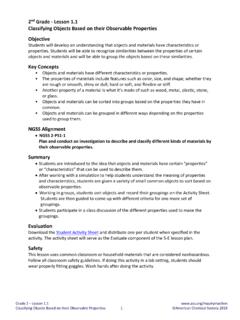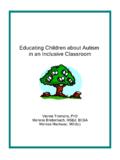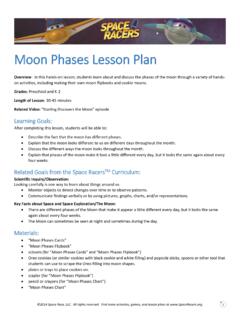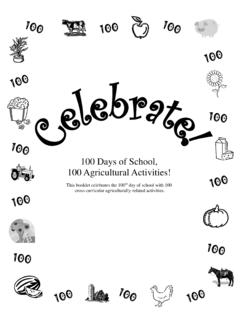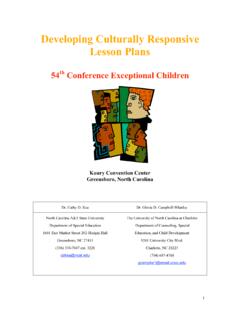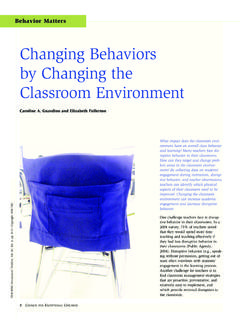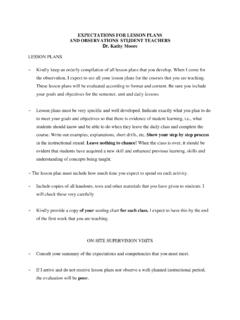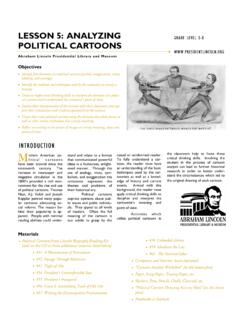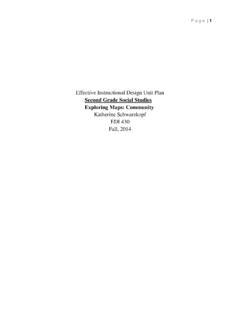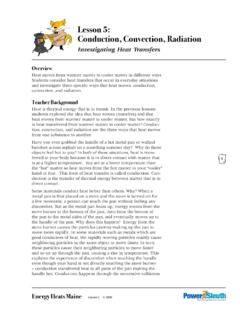Transcription of Georgia Standards of Excellence Curriculum Frameworks
1 These materials are for nonprofit educational purposes only. Any other use may constitute copyright infringement. Georgia Standards of Excellence Curriculum Frameworks GSE Third Grade Unit 6: Measurement Mathematics Georgia Department of Education Georgia Standards of Excellence Framework GSE Measurement Unit 6 Mathematics GSE Third Grade Unit 6: Measurement Richard Woods, State School Superintendent July 2017 Page 2 of 106 All Rights Reserved TABLE OF CONTENTS Unit Overview .. 3 Standards for Mathematical Practice .. 3 Content Standards .. 4 Big Ideas .. 5 Essential Questions .. 5 Concepts and Skills to Maintain .. 6 Strategies for Teaching and Learning .. 7 Selected Terms and Symbols .. 9 Tasks .. 10 Intervention Table .. 15 Let s Talk About Time .. 17 Time to Get Clean .. 21 Daily Schedule .. 26 Plane Ride.
2 31 How Do I Spend My Day? .. 43 How Many Paper Clips? .. 50 Setting the Standard .. 56 Making a Kilogram .. 61 Worth the Weight .. 65 Fill It Up! .. 72 More Punch Please! .. 77 The Data Station .. 82 The Magic Number! .. 88 It s in the Data .. 92 Culminating Task Field Trip to the Zoo .. 99 IF YOU HAVE NOT READ THE THIRD GRADE Curriculum OVERVIEW IN ITS ENTIRETY PRIOR TO USE OF THIS UNIT, PLEASE STOP AND CLICK HERE: Return to the use of this unit once you ve completed reading the Curriculum Overview. Thank you. Georgia Department of Education Georgia Standards of Excellence Framework GSE Measurement Unit 6 Mathematics GSE Third Grade Unit 6: Measurement Richard Woods, State School Superintendent July 2017 Page 3 of 106 All Rights Reserved UNIT OVERVIEW In this unit students will: Tell and write time to the nearest minute and measure time intervals in minutes.
3 Solve elapsed time, including word problems, by using a number line diagram. Reason about the units of mass and liquid volume. Understand that larger units can be subdivided into equivalent units (partition). Understand that the same unit can be repeated to determine the measure (iteration). Understand the relationship between the size of a unit and the number of units needed (compensatory principle). Graph data that is relevant to their lives. While exploring data concepts, students should Pose a question, Collect data, Analyze data, and Interpret data (PCAI). Standards FOR MATHEMATICAL PRACTICE (SMP) This section provides examples of learning experiences for this unit that support the development of the proficiencies described in the Standards for Mathematical Practice. The statements provided offer a few examples of connections between the Standards for Mathematical Practice and the Content Standards of this unit.
4 The list is not exhaustive and will hopefully prompt further reflection and discussion. 1. Make sense of problems and persevere in solving them. Students make sense of problems involving intervals of time, measuring and estimating liquid volume and masses, and interpreting scaled picture graphs and scaled bar graphs. 2. Reason abstractly and quantitatively. Students demonstrate abstract reasoning by connecting quantity of data and representing the data using a scaled picture graph or scaled bar graph. 3. Construct viable arguments and critique the reasoning of others. Students construct and critique arguments regarding their solutions for word problems involving addition and subtraction of time intervals in minutes. 4. Model with mathematics. Students represent data in multiple ways using a scaled picture graph, scaled bar graph and line plot.
5 Additionally, they record their thinking using words, pictures, and numbers to further explain their reasoning in problems throughout many of the tasks in this unit. 5. Use appropriate tools strategically. Students utilize a number line to assist with determining time intervals to the nearest minute. Students also use estimation when determining liquid volume and masses. Georgia Department of Education Georgia Standards of Excellence Framework GSE Measurement Unit 6 Mathematics GSE Third Grade Unit 6: Measurement Richard Woods, State School Superintendent July 2017 Page 4 of 106 All Rights Reserved 6. Attend to precision. Students attend to the language of real-world situations to determine appropriate ways to organize data. 7. Look for and make use of structure. Students make sense of structure when looking at multiplicative patterns in word problems.
6 8. Look for and express regularity in repeated reasoning. Students continually evaluate their work by asking themselves Does this make sense? *Mathematical Practices 1 and 6 should be evident in EVERY lesson! CONTENT Standards ADDRESED Content Standards are interwoven and should be addressed throughout the year in as many different units and activities as possible in order to emphasize the natural connections that exist among mathematical topics. Solve problems involving measurement and estimation of intervals of time, liquid volumes, and masses of objects. Tell and write time to the nearest minute and measure elapsed time intervals in minutes. Solve word problems involving addition and subtraction of time intervals in minutes, , by representing the problem on a number line diagram, drawing a pictorial representation on a clock face, etc.
7 Measure and estimate liquid volumes and masses of objects using standard units of grams (g), kilograms (kg), and liters (l). Add, subtract, multiply, or divide to solve one-step word problems involving masses or volumes that are given in the same units, , by using drawings (such as a beaker with a measurement scale) to represent the problem. Represent and interpret data. Draw a scaled picture graph and a scaled bar graph to represent a data set with several categories. Solve one- and two-step how many more and how many less problems using information presented in scaled bar graphs. For example, draw a bar graph in which each square in the bar graph might represent 5 pets. Generate measurement data by measuring lengths using rulers marked with halves and fourths of an inch. Show the data by making a line plot, where the horizontal scale is marked off in appropriate units whole numbers, halves, or quarters.
8 For more detailed information about unpacking the content Standards , unpacking a task, math routines and rituals, maintenance activities and more, please refer to the Grade Level Overview. Georgia Department of Education Georgia Standards of Excellence Framework GSE Measurement Unit 6 Mathematics GSE Third Grade Unit 6: Measurement Richard Woods, State School Superintendent July 2017 Page 5 of 106 All Rights Reserved BIG IDEAS The duration of an event is called elapsed time and it can be measured. Mass and Liquid Mass and liquid volume are important parts of everyday life and can determined a variety of ways. Larger units can be subdivided into equivalent units (partition). The same unit can be repeated to determine the measure (iteration). There is a relationship between the size of a unit and the number of units needed (compensatory principle).
9 Data and Charts, tables, line plot graphs, pictographs, Venn diagrams, and bar graphs may be used to display data. One way to compare data is through the use of graphs. The scale increments used when making a bar graph is determined by the scale intervals being graphed. ESSENTIAL QUESTIONS Telling What strategies can I use to help me tell and write time to the nearest minute and measure time intervals in minutes? How can I use what I know about number lines to help me figure out how much time has passed between two events? Liquid Volume and What happens when your units of measure change? Why is it important to know the mass of an object ? In what ways can we determine the mass of an object ? What units are appropriate to measure mass? How are units in the same system of measurement related? What strategies could you use to figure out the mass of multiple objects?
10 What are some ways I can measure the liquid volume? Graphing and How are tables, bar graphs, and line plot graphs useful ways to display data? How can you use graphs to answer a question? How can surveys be used to collect data? How can surveys be used to gather information? How can graphs be used to display data gathered from a survey? Georgia Department of Education Georgia Standards of Excellence Framework GSE Measurement Unit 6 Mathematics GSE Third Grade Unit 6: Measurement Richard Woods, State School Superintendent July 2017 Page 6 of 106 All Rights Reserved CONCEPTS AND SKILLS TO MAINTAIN It is expected that students will have prior knowledge/experience related to the concepts and skills identified below. It may be necessary to pre-assess in order to determine if time needs to be spent on conceptual activities that help students develop a deeper understanding of these ideas.










